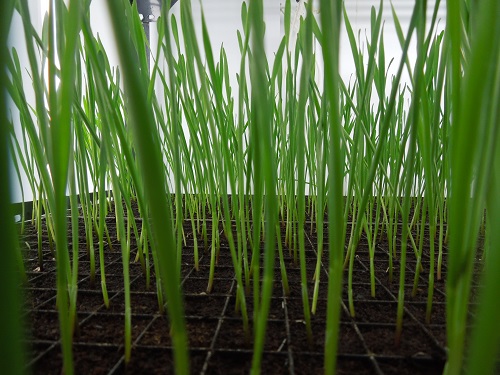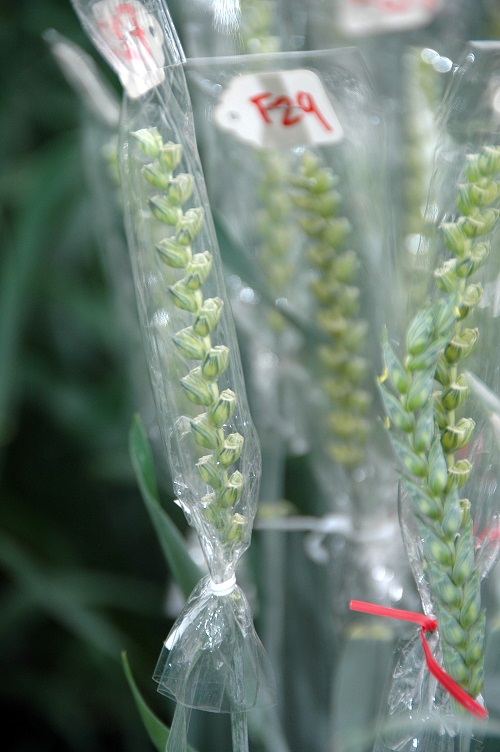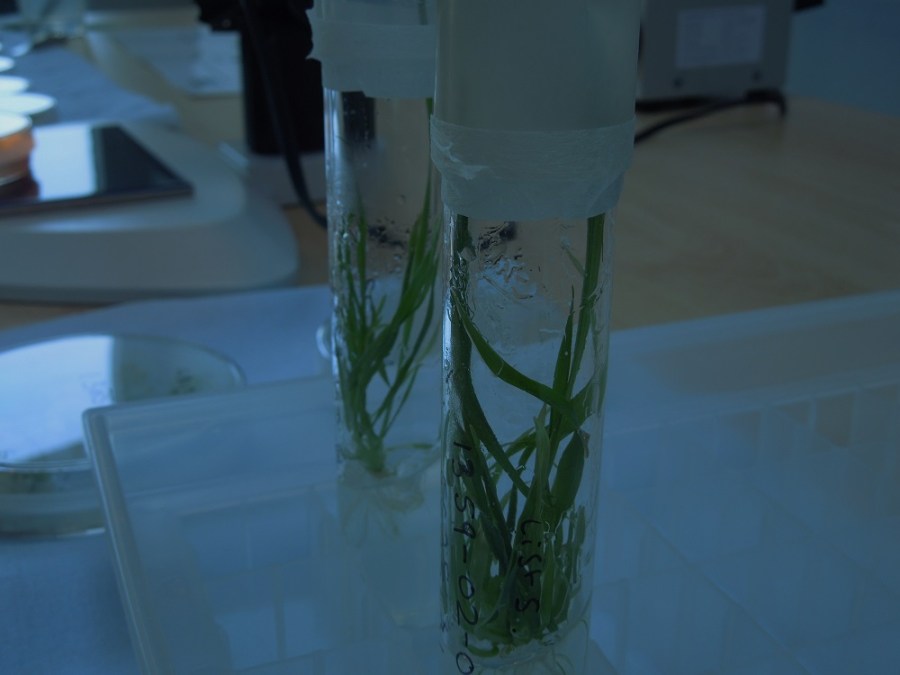The Genetic Improvement Networks have revolutionised plant breeding in the UK. CPM reports on the achievements of the GINs and how they will contribute to the varieties of the future.
The traits being investigated are all to help improve crop resilience.
By Lucy de la Pasture
Growers are at the sharp end of crop production – facing the very real problems of increasingly insensitive pests and disease populations and an ever-decreasing number of active ingredients at their disposal. Solutions found in the genes of plants are routinely sought after to bolster crop production where pesticides have nothing left to offer, but it’s akin to looking for a needle in a haystack.

WGIN has catalysed a boom in pre-breeding research.
Commercial plant breeders have been working hard to find new resistance traits for pests and pathogens, but it’s the work carried out by pre-breeders and facilitated by the Genetic Improvement Networks (GINs), that has given the whole industry a shot in the arm, explains Dr Malcolm Hawkesford, Head of Plant Science Department and Rothamsted lead on the Designing Future Wheat programme.
The four GINs – WGIN (wheat), OREGIN (OSR) VeGIN (brassicas, leafy salads, onions and carrots) and PCGIN (Pulses) – are DEFRA-funded and were set up in 2003, with the overall aim of generating pre-breeding material carrying novel traits so breeding companies could ultimately produce improved varieties, he explains.

Work is being done to discover and transfer new traits to modern hexaploid wheats.
“At the time of WGINs conception, it was widely felt that there was a disconnect between academia and commercial plant-breeding companies. The idea was to bring them together to improve collaboration and communication between researchers and industry. WGIN has succeeded in doing this and much more, proving to be the catalyst for an explosion of further joint projects across the industry.”
WGIN, now in its third round of DEFRA-funding, is a project with scientists collaborating from eight different organisations, representing the substantial majority of the UK’s expertise in wheat genetics and breeding.
The Network’s activities have been managed through a management team comprising representatives from the partners (Rothamsted Research (RRes), the John Innes Centre (JIC) and the University of Nottingham (UoN)), Defra and with representation from ADAS, University of Bristol (UoB), NIAB, AHDB, BBSRC and all the UK-based plant-breeding companies.
As well as facilitating networking, science remains the raison d’être for all the GINs, stresses Malcolm Hawkesford. In particular, the generation of genetic and genomic resources is at the core of WGIN, free for use by all plant breeders in their commercial programmes with no Intellectual Property (IP) attached.
Key to WGIN’s ability to produce pre-breeding material are several historic collections of wheat seed, one of which is the Watkins collection, curated by JIC.
“The Watkins collection contains selections of landrace wheats (durum and aestivum forms) from 32 countries around the world, assembled as a working collection in the late 1920s by A. E. Watkins in Cambridge, who used the official channels of the Board of Trade in London to request materials from abroad.
“The collection initially consisted of several thousand accessions, which were used to study the genetics of a range of ear characteristics including awning and colouration of the glumes and grains. Over time and due to poor storage during WWII, a great many of these were lost.
“The current collection stands at 1291 accessions and offers a unique snapshot of genetic diversity and geographic distribution in wheat prior to modern plant breeding and the green revolution. Some very interesting traits are contained within this collection,” comments Malcolm Hawkesford.
As well as generating pre-breeding material, WGIN is also exploring several traits identified in collaboration with commercial breeders. The six main traits being explored are nitrogen use efficiency and grain quality QTLs (quantitative trait loci), drought tolerance, resistance to take-all disease, introgression of extreme resistance to septoria leaf blotch from a diploid wheat and resistance to aphids.
All the traits being investigated are to counter the ‘perfect storms’ brewing in the face of climate change, intensive production and resistance issues. The grain aphid (Sitobion avenae) and bird cherry oat aphid (Rhopalosiphum padi) for example, are vectors of BYDV, a potentially increasing robber of yield in the UK as control options become more limited.
“Discovering a heritable plant resilience to aphid attack would be highly desirable, for both sustainability and ecological reasons, but phenotyping studies conducted to date have shown little or no resilience in elite hexaploidy wheat varieties or Watkins collection wheat landraces,” explains Malcolm Hawkesford.
“Phenotyping studies have revealed more promising results with diploid wheat species, particularly goat-grasses, Aegilops tauschii and Aegilops speltoides, and einkorn wheat (Triticum monococcum). In these species, aphid nymph production and survival were significantly reduced or absent in some lines.”
In the earlier WGIN1 and WGIN2 projects, a global collection of T. monococcum accessions was assembled at Rothamsted Research, with the aim of identifying novel traits that could be used for the improvement of modern hexaploid wheat, and a small number of accessions were genotyped for aphid resistance.
As part of WGIN3, some of these promising mapping populations are being further investigated to see if this trait can eventually be transferred into elite hexaploid wheat.
“The traits being investigated in this third stage of the WGIN project are all to help improve crop resilience to ensure good yields in difficult seasons,” he adds.
AHDB senior scientist, Dhan Bhandari, is a member of the WGIN steering group committee and says the project is beginning to assess its output and quantify the many things that WGIN has delivered, over and above the science which is at its core.
“One of the unanticipated spin-offs from the GINs has been a large number of collaborative projects and major new funding for wheat research using WGIN knowledge and resources. The £4.52M investment in WGIN from DEFRA has yielded a further £27M of BBSRC-funding for wheat research, £13M from other sponsors, £29M for WGIN project leads and collaborators and a further £11M won by non-WGIN project leads,” he highlights.
Malcolm Hawkesford adds that the WGIN project has led to a longer and larger pre-breeding project – ‘Wheat Improvement Strategic Improvement’ (WISP). Funded by BBSRC, the WISP consortium brings together experts in wheat genetics and breeding from five institutions – JIC, NIAB, University of Nottingham, University of Bristol and Rothamsted Research.
“But the ultimate consequence of WGIN has been the setting up of a co-ordinated UK programme of wheat breeding research – ‘Designing Future Wheat’ (DFW). For the first time ever, a fully-integrated, cross-institutional consortium has been set-up, funded by BBSRC and it involves more than 30 groups.
“DFW will take forward the pre-breeding work of WGIN and WISP to produce a minimum of 96 pre-breeding lines, and all the genetic markers and information needed to provide ‘breeder toolkits’ of genetic material, free of IP,” he explains.
Although the concept of WGIN has been taken on and expanded in these further projects, WGIN continues to produce useful output, embracing new technologies such as UAVs and phenotyping platforms, soil probes, rapid genome analyses for pests/pathogens, wheat gene editing and the development of F1 hybrid wheat crops, in the quest for germplasm that will underpin UK growers move towards more sustainable intensification.
“Within WGIN, we’re developing remote sensing technology using drones on the input trials, where we’re looking at crop performance in relation to its nutrient use efficiency and yield stability. We’re also developing onboard technologies and post-capture analysis of images to help assess the performance of input traits across the trials, and identify varieties that are more stable.
“In the latest phase of WGIN, new genetic tools are being used that will have a huge value in the future, helping us to speed up the generation of genetic markers and analyse traits,” he adds.
The latest developments in WGIN will be discussed at a meeting held at Rothamsted (30 Nov) for all stakeholders, including farmers and agronomists, highlights Malcolm Hawkesford. And for those put off by the mysterious world of genetics, it’s not just a meeting for ‘high-brow’ scientists.
“There will be a mixture of presentations from market related to technical. Usually there’s a ‘panel’ discussing a hot wheat topic, looking at applied issues that would be of particular value to growers,”
Summing up, Dhan Bhandari believes the spirit of collaboration, both within WGIN and catalysed by the project, is benefiting the research and breeding communities in the UK and internationally. Although the output to growers isn’t an immediate process and new varieties take a while to reach market, the traits currently being developed will provide a huge benefit at the sharp-edge of farming in years to come.
Bridging the valley of death
Before the GINs were set up, there was a gap – often referred to as ‘the valley of death’ – separating great research and plant breeding, explains Dr Penny Maplestone, chief executive of the British Society of Plant Breeders.
“There was no meeting in the middle because commercial plant breeders simply don’t have the huge resources needed to carry out pre-breeding work. Likewise, the research institutions didn’t have the funding to reach across the gap either,” she explains.
Penny Maplestone acknowledges the GINs as a fantastic initiative, generating a publicly available output, stimulating collaboration and effectively bridging the valley of death. But what does she believe the GINs have contributed from a commercial point of view?
“One of the achievements of the GINs is the development of the genetic resources they now have available. The numerous collections of germplasm haven’t been of much direct use to plant breeders in the past, but the GINs have allowed academia to characterise the collections, bringing order to chaos. They’ve then made these organised characters and traits available to breeders, allowing them to create diversity in their breeding programmes,” she says.
A further benefit she identifies is the development of a much closer relationship between commercial breeders, who’ve discovered it’s to everyone’s advantage to work together on pre-breeding programmes.
“At the pre-breeding stage, there’s no commercial competitive advantage to be gained so working together makes good sense,” she points out.
And there’s been a spin-off from this closer collaboration between plant breeders. “By bringing commercial companies together in this way, new ideas have been generated and funding found beyond the GIN initiative, accelerating the improvement in the varieties plant breeders are bringing through to market.”
The GIN projects are something Penny Maplestone believes have been very successful in fulfilling their objectives of generating genetic resources and building networks and she’s keen to see GINs continue.
“We need to generate new ideas to keep plant breeding fresh and relevant, moving in the direction that will be of most use to growers to help them tackle the challenges they face in the field,” she concludes.
Research round-up
The GINs are DEFRA-funded, supported by AHDB in-line with their Strategy 2017–2020 (Inspiring Success), which states “Pre-breeding research and development is regarded as long term, high risk and expensive and already covered by organisations such as the Biotechnology and Biological Sciences Research Council (BBSRC). Compared to the impact AHDB can have on the industry through funding more near market research, this is seen as a low priority for AHDB which will aim to retain influence in this area without co-funding.”




